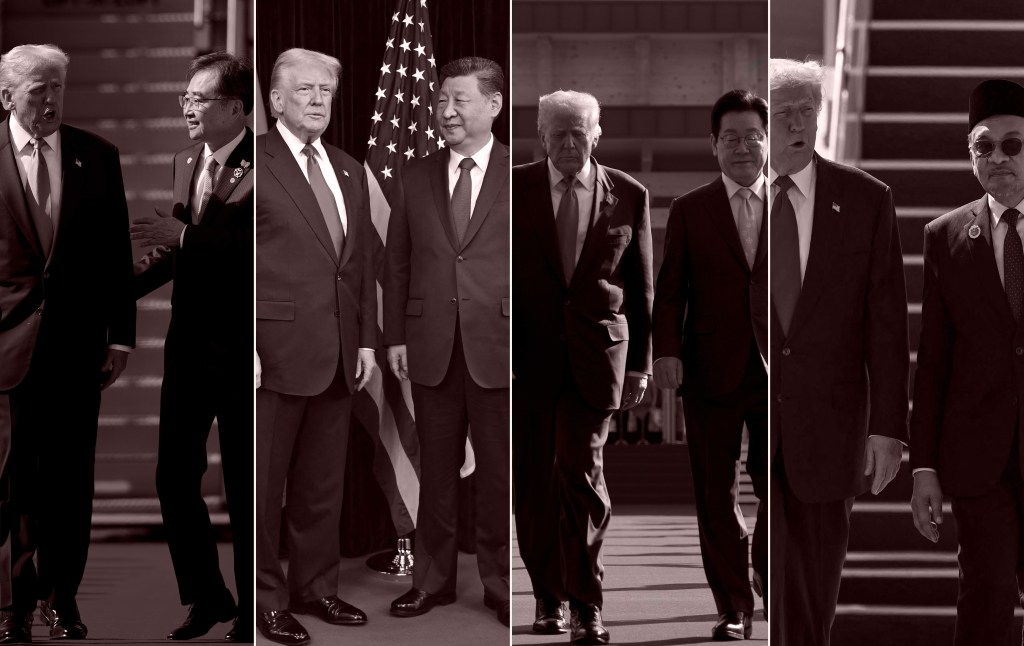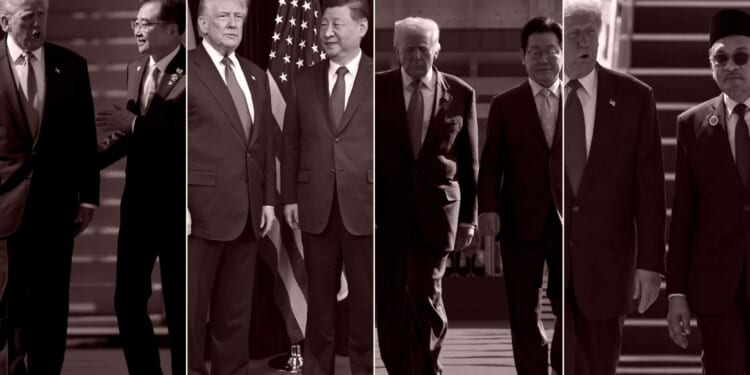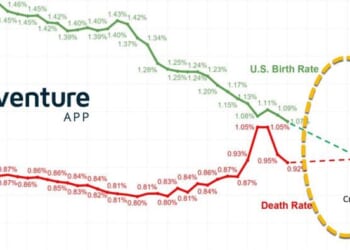
The images from President Donald Trump’s Asia trip are the familiar showcases of pageantry that often accompany state visits by U.S. presidents. Trump’s trip did yield real policy gains. In Kuala Lumpur, he brokered new agreements on trade with Thailand, Malaysia, Cambodia, and Vietnam. With treaty allies Japan and South Korea, he announced new investment commitments and defense initiatives to bolster allied deterrence. In his meeting with Chinese President Xi Jinping, the two leaders cooled tensions, even if the concessions involved fell well short of comprehensive change.
Beneath the lavish gifts and other pomp, however, lie growing structural strains with America’s allies. The atmosphere in allied capitals is increasingly anxious as China, Russia, and North Korea assert their interests in the region—and as the United States wields coercive diplomacy and tariffs to exact allied contributions like greater defense spending, favorable trade agreements, and large investment deals in the United States. What are we to make of all this? One set of facts suggests that U.S. alliances are strong, with deepening and expanding initiatives. Another reveals strain, discontent, pressure, and uncertainty. How should we think about these disparate realities? How do we cut through the noise to identify the trends that truly matter in U.S. alliance management? More directly: What makes alliances hold—or break—under pressure?
Loyalty, voice, and exit: a framework for alliances.
American economist Albert Hirschman offers a useful framework for answering these questions. He argued that political coalitions, such as alliances, need two mutual behaviors to be sustainable: loyalty and voice. Loyalty provides a foundation for trust. In alliance terms, this translates into credible and demonstrable defense commitments, consistent signals of reassurance, and regular deterrence initiatives. Voice serves as a mechanism for dissent and reconciliation—structured channels to express disagreement, argue, and repair relationships as equal partners. When an alliance lacks mutual loyalty and sustained dialogue, it risks one or more partners choosing to exit the alliance, ending the arrangement. This framework helps sift through discordant and contradictory headlines to clarify what matters most for the current state of U.S. alliances. From this interplay of loyalty and voice, four distinct contexts emerge: high degrees of loyalty and voice, high loyalty but low voice, low loyalty and high voice, and low degrees of both loyalty and voice.
Of course, the ideal alliance is characterized by high degrees of loyalty and voice, a quintessential cocktail for a secure and resilient partnership. For most of the post-World War II period, this dynamic defined U.S. alliance management. The U.S.-Japan alliance is a prime example. Driven by shared interests, economic interdependence, and mutual dependence, the two nations have historically shown deep loyalty toward one another. Special relationships formed between leaders—Dwight Eisenhower and Nobusuke Kishi, Ronald Reagan and Yasuhiro Nakasone, George W. Bush and Junichiro Koizumi, and, during his first term, Donald Trump and Shinzo Abe. The two nations have also maintained durable dialogue and reconciliation within the alliance. In the 1950s, when Japan viewed the U.S.-Japan Security Treaty as unequal, Washington agreed to renegotiate. It continued to accommodate Japan’s concerns in the 1960s over Okinawa’s legal status and in the 1990s over Japan’s demands for expanded criminal jurisdiction over U.S. forces stationed in the country. Japan, in turn, respected U.S. concerns, particularly regarding burden-sharing. Despite inevitable differences, this combination of loyalty and openness to voice provided the foundation for a secure alliance.
The next two dynamics share similarities but differ in crucial ways. One is high loyalty but low voice. A historical example comes from the 1956 Suez Crisis. While the United Kingdom and France publicly negotiated with Egypt’s Gamal Abdel Nasser over control of the Suez Canal, the European leaders surreptitiously concluded the Protocol of Sevres with Israel, arranging an Israeli attack on Egypt to manufacture a pretext for an Anglo-French intervention. Blindsided by the intervention, Washington reacted sharply, condemning the attack in the United Nations and threatening financial consequences if London and Paris did not withdraw. The break between Washington and London and Paris was real and tense. Still, the two European nations were vital American allies with relationships forged across two world wars. While their refusal to give Washington a voice fractured coordination and reconciliation, their loyalty to the broader Western alliance remained deep and was sufficient to repair the alliance and bring it back to equilibrium.
The opposite scenario—low loyalty but high voice—occurs when alliance deliberation remains robust but mutual trust erodes. The U.S.-Philippines relationship under former President Rodrigo Duterte illustrates this pattern. During his tenure, from 2016-2022, Duterte courted Beijing and undermined the foundations of the alliance, weakening loyalty. Yet procedures upholding the alliance persisted, if tensely: Bilateral meetings continued, joint exercises proceeded, and even the controversial Visiting Forces Agreement that provided legal grounds for the presence of U.S. forces was renewed. Despite strained ties, mechanisms for discussion and reconciliation held. Both high-loyalty/low-voice and low-loyalty/high-voice combinations create instability, but neither necessarily produces an irreconcilable sundering.
The final quadrant is the maelstrom of low loyalty and low voice that brings the most severe consequences. Trust collapses, communication fails, and each grievance feeds the next, resulting in an exit from the alliance. This is not theoretical; it has happened before. After World War II, the United States formed the ANZUS alliance with Australia and New Zealand. For decades it held firm, even through the turmoil of the Vietnam War. But in the 1980s, when New Zealand refused to host U.S. nuclear-armed submarines, a vicious cycle of mistrust emerged. Washington viewed Wellington as disloyal; Wellington saw Washington as deaf to its dissent. The result was rupture and exit: the United States suspended its defense relationship, downgrading New Zealand from ally to friend. When an alliance loses its core pillars of loyalty and voice, breakdown quickly follows.
The United States is winning deals—and losing allies.
Leveraging Hirschman’s framework, we can weave today’s contradictory headlines into a coherent picture of Trump’s alliance management. Yet the portrait that emerges is troubling.
On the allied side, most partners have demonstrated remarkable loyalty to their alliances with the United States and offered Trump and his team substantial voice to air concerns about allied contributions. European and NATO leaders, in particular, have excelled early in this second Trump administration. NATO Secretary-General Mark Rutte has warmly embraced the president, providing him a platform to express frustration while facilitating mechanisms for repair. Earlier this year, Trump attended a NATO summit where most allies agreed to meet his demand for defense-related spending equivalent to 5 percent of GDP. Pacific allies have been slower to embrace Trump’s approach, but even there, leaders have reaffirmed loyalty and granted Washington space to voice its views. Taiwan and South Korea have both agreed to boost defense spending, moving toward NATO-style benchmarks. In Tokyo, new Prime Minister Sanae Takaichi has placed a robust U.S.-Japan alliance at the heart of her foreign policy agenda. It’s clear that Pacific allies are willing to engage the Trump administration on the substance of its concerns.
Washington, however, has been too cavalier in handling its alliances. The danger the United States faces is not one of substance but of conduct—behavior that erodes the core attributes needed to sustain secure partnerships.
First, Trump frequently calls into question America’s willingness to contribute to allied deterrence or uphold Article 5 security commitments. Whether these threats are negotiating tactics or genuine doubts, the effect is the same: He signals to allies and adversaries alike that U.S. loyalty is uncertain. Even when reassurances follow, repeated hints of abandonment and continued troop withdrawals reverberate more powerfully than any press conference affirmation.
Second, the administration has failed to provide allies proper channels for dissent and reconciliation. Calls for defense spending increases and imposing tariffs have come in the form of ultimatums. Rather than treating allies as equal partners, the administration has weaponized U.S. leverage to coerce incremental gains at the expense of cohesion. Washington often offers allies no real forum to voice disagreement or repair fractures.
If allies cannot count on baseline loyalty and cannot voice their concerns as equal partners, they will eventually find ways to exit—which can take many forms. The least likely—though not impossible—is a dramatic, made-for-Hollywood announcement abrogating an alliance. The U.S.-New Zealand rupture reminds us this is not unimaginable. But given today’s threats, most allies will seek to maintain some security connection to the United States. More plausibly, they will begin to develop independent policies that diverge from U.S. interests or hedge against a coercive America.
Indeed, some already are. As doubts grow about American commitments, reports suggest allies are considering their own nuclear options. In South Korea, recent polls show that 76 percent of citizens support developing an indigenous nuclear arsenal. Policymakers in Japan and Poland are debating similar steps. Such moves would accelerate global proliferation and heighten insecurity—precisely when strong American loyalty and open voice could ease rising tensions.
The United States has long derived its power not just from the scale of its military or economy, but from the trust it has earned. That trust is the dividend of decades of trust and open discussion among allies. If Washington continues to trade those foundations for short-term leverage, it risks converting allies into hedgers and friends into fence-sitters. The choice before the Trump administration is not a matter of substantive policy but behavior. Loyalty and voice cannot be commanded; they must be cultivated.















